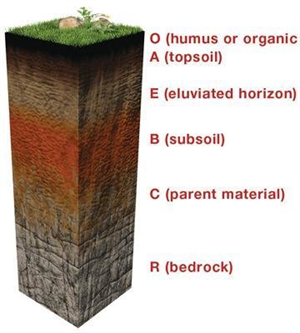PDF chapter test TRY NOW
The soil is formed in layers during the formation. Each layer of the soil is called a horizon. A soil profile is the depiction of the vertical arrangement of these soil horizons below the earth's surface. Each horizon runs parallel to the other and has distinct characteristics and properties. It extends from the top-soil to the parent materials. It plays a vital role in maintaining the nutrients of the soil. There are five horizons represented using the letters O, A, E, B, C and R.

O-Horizon – The upper layer of top soil – Organic horizon, consist mainly decomposed plant and animal matters – Darker in colour.
A-Horizon – Top soil layer – High humus and minerals content – Plant roots penetrate up to this layer.
E-Horizon – Consist of nutrients leached away from above O and A horizons.
B-Horizon – Sub-Soil layer – Found below the top soil – Comparatively hard and has a less humus content.
C-Horizon – A layer of weathered bedrock that lies below the sub-soil layer – Made up of fragments of stones and rock.
R-Horizon – Unweathered parent material – Compacted and cemented layer.
Reference:
https://www.researchgate.net/figure/Typical-Soil-Profile_fig3_334454668
